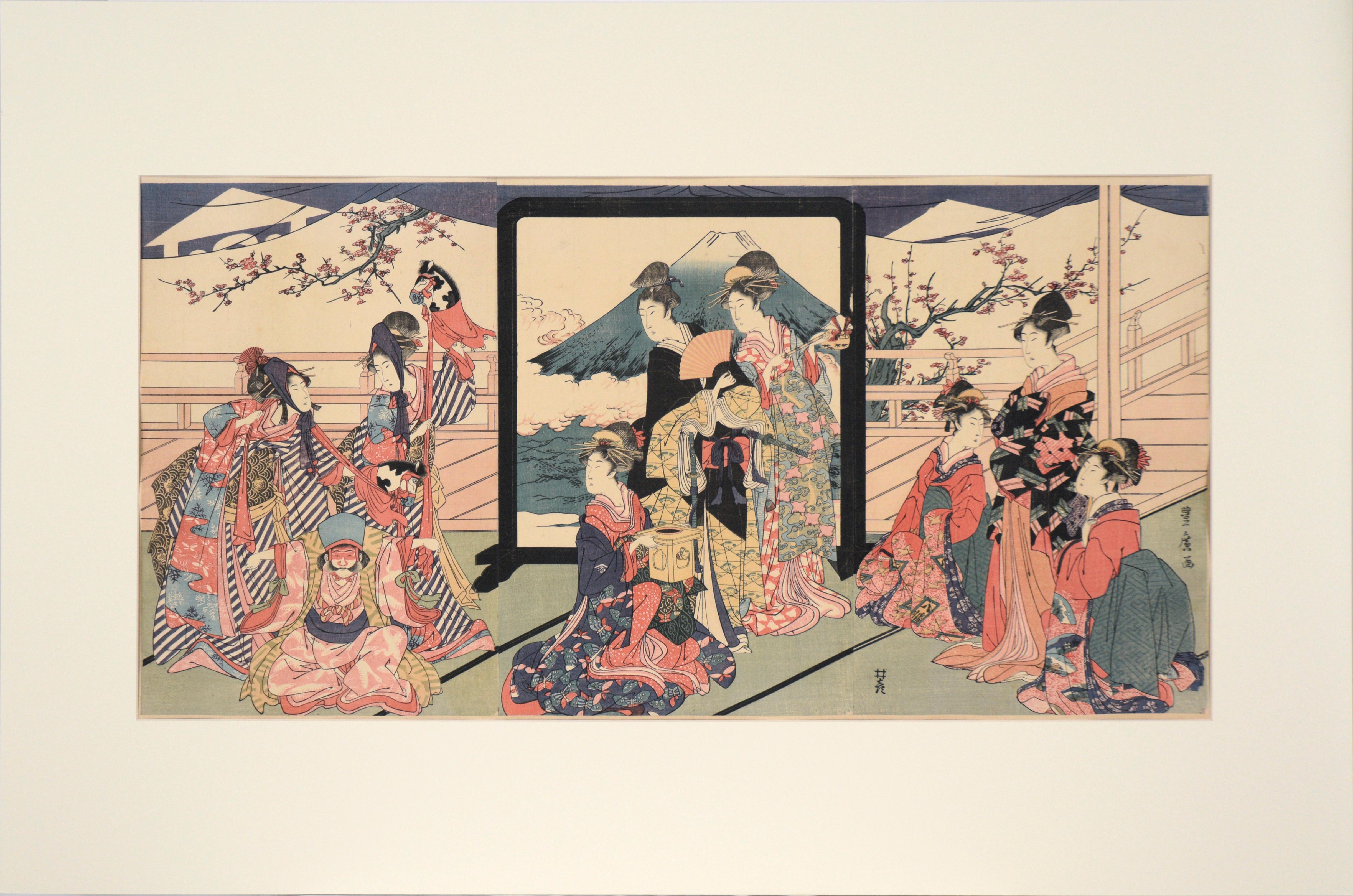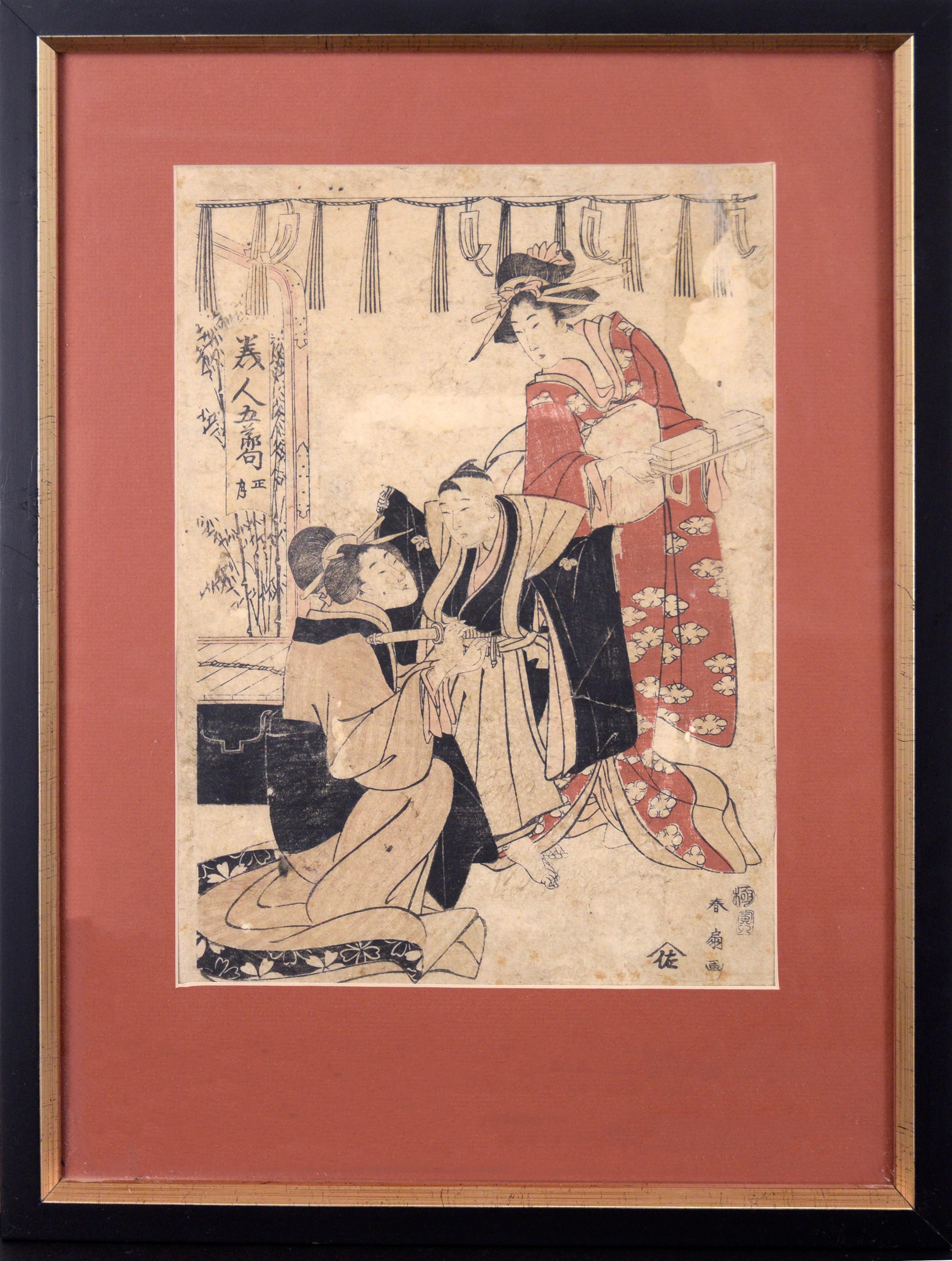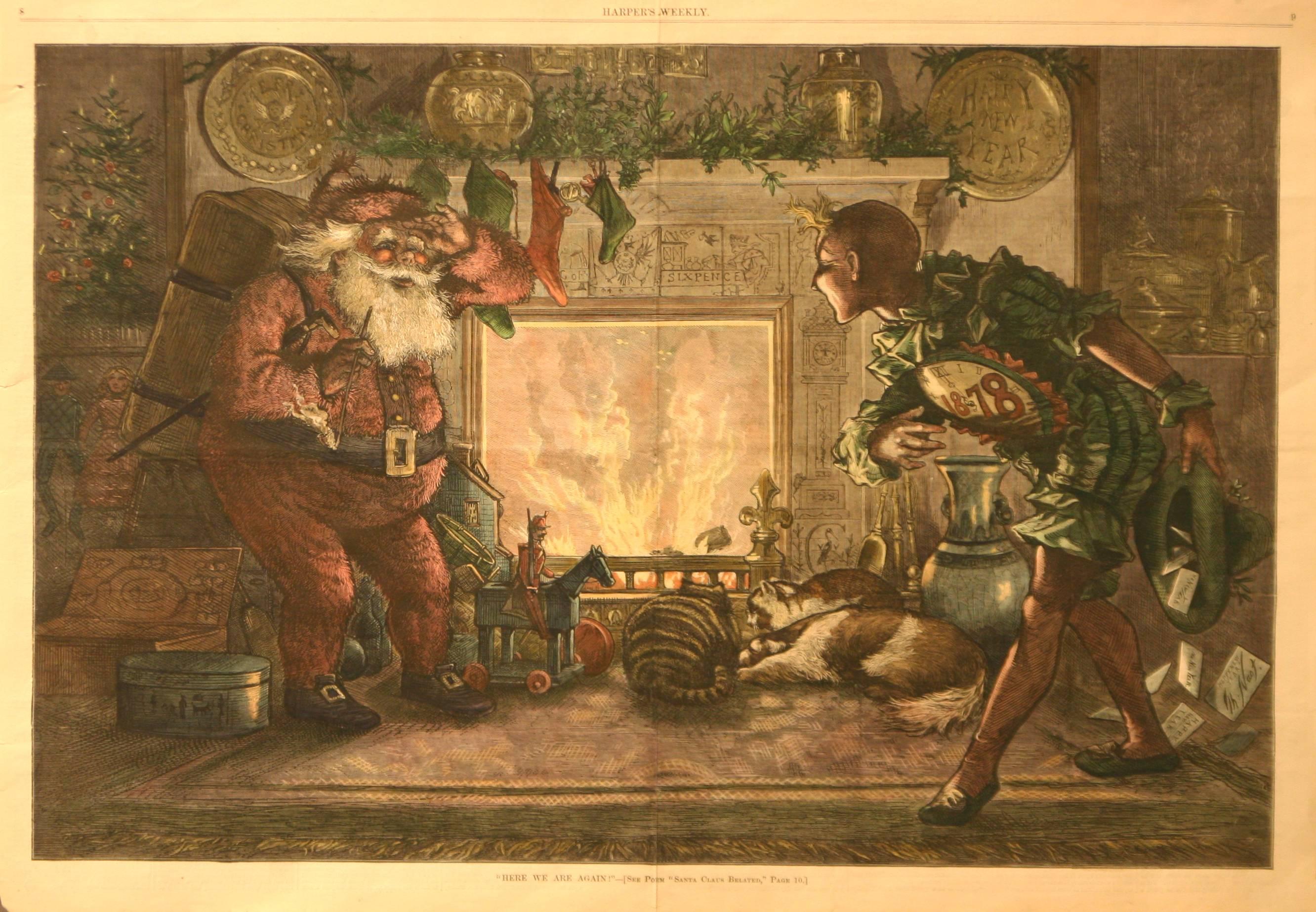Items Similar to 'Interior of the Kannon Temple at Asakusa' — Early Edition 1930s Woodblock Print
Want more images or videos?
Request additional images or videos from the seller
1 of 3
NARAZAKI EISHO'Interior of the Kannon Temple at Asakusa' — Early Edition 1930s Woodblock Print1932
1932
About the Item
NARAZAKI EISHO (1864-1936), 'Asakusa Kannon-do no naido' (Interior of the Kannon Temple at Asakusa), color woodblock print, 1932. Signed Eisho lower right, with the artist’s red seal beneath. A fine impression with fresh colors; the full sheet with slight overall age toning, a drying tack hole in the upper left margin, in overall excellent condition.
Vertical oban: image size 14 3/16 x 9 9/16 inches (360 x 243 mm); sheet size 15 1/4 x 10 1/2 inches (387 x 267 mm).
Published by Watanabe Shozaburo. A rare first or early edition impression with the Watanabe publisher’s seal “C” (1929-1942) in the lower left margin and the title and date in the lower right margin.
Collections: Harvard Art Museums, Los Angeles County Museum of Art, Museum of Fine Arts Boston.
Literature: 'Shin-Hanga: New Prints in Modern Japan,' Kendall Brown, Hollis Goodall-Cristante, Los Angeles County Museum of Art, 1996, p. 83, figure 113; 'Japanese Wood-block Prints,' Shizuya Fujikake, Japan Travel Bureau, 1938, p. 94, 95; 'The Legacy of Japanese Printmaking,' Barry Till, Art Gallery of Greater Victoria, 1986, plate 62; 'Modern Japanese Prints: The Twentieth Century,' Amanda T. Zehnder, Carnegie Museum of Art, 2009, p. 132; 'Hanga ni miru Tokyo no fukei; Kanto daishinsai kara senzen made, Ota Kuritsu Kyodo Hakubutsukan,' 2002, pl. 213, p. 50.
ABOUT THE IMAGE
The scene depicted is of the interior of the Asakusa Kannon Temple on New Year’s Day. Large celebratory lanterns hang from the high ceiling; the one in the foreground bears a 17th-century Buddhist symbol. The Buddhist temple Sensōji, also known as Asakusa Kannon Temple, is located in Asakusa, Tokyo. Completed in 645 AD, it is Tokyo's oldest temple and one of its most colorful and popular.
ABOUT THE ARTIST
Narazaki Eishō (1864-1936) was born in Edo (modern-day Tokyo), Japan. He was a highly esteemed artist known for his mastery of the traditional Japanese woodblock print technique, ukiyo-e. Eishō's life and work spanned a transformative period in Japanese history, witnessing the transition from the Edo period to the Meiji era and the subsequent modernization of Japan.
Eishō initially trained under the guidance of his father, Narazaki Kōgyo, a well-known artist and printmaker. Under his father's tutelage, Eishō honed his skills in woodblock printing and developed a deep appreciation for the rich artistic traditions of Japan. He demonstrated remarkable talent from a young age, quickly gaining recognition for his intricate designs and meticulous craftsmanship.
As Japan underwent rapid modernization and cultural shifts during the Meiji era, Eishō remained committed to preserving and revitalizing the art of ukiyo-e, which was facing challenges from Western influences and changing tastes. He drew inspiration from classical ukiyo-e masters, such as Hokusai and Hiroshige, and contemporary trends in Japanese art, blending traditional techniques with innovative approaches.
Eishō's prints, celebrated for their beauty, craftsmanship, and evocative portrayal of Japanese life and culture, encompassed various subjects, including landscapes, portraits, historical scenes, and depictions of kabuki actors and geisha. He demonstrated a keen eye for capturing the beauty and dynamism of everyday life in Japan, infusing his prints with vibrant colors, intricate details, and a sense of elegance and refinement.
One of Eishō's notable achievements was his collaboration with the publisher Watanabe Shōzaburō, who played a pivotal role in the revival of ukiyo-e during the early 20th century. Together, they produced a series of prints featuring famous landmarks, scenic views, and traditional customs of Japan, which gained popularity both domestically and internationally.
Throughout his career, Eishō remained dedicated to the preservation and promotion of ukiyo-e as a vital art form. He also contributed to the scholarly study of Japanese prints, publishing books and articles on the history and techniques of ukiyo-e.
Eishō's prints are represented in the collections of the Art Institute of Chicago, Carnegie Museum of Art, Georgetown University, Harvard Art Museums, University of Wisconsin, The Lavenberg Collection of Japanese Prints, and the Philadelphia Museum of Art.
- Creator:NARAZAKI EISHO (1864 - 1936, Japanese)
- Creation Year:1932
- Dimensions:Height: 14.188 in (36.04 cm)Width: 9.563 in (24.29 cm)
- Medium:
- Period:
- Condition:
- Gallery Location:Myrtle Beach, SC
- Reference Number:
About the Seller
5.0
Recognized Seller
These prestigious sellers are industry leaders and represent the highest echelon for item quality and design.
Platinum Seller
These expertly vetted sellers are 1stDibs' most experienced sellers and are rated highest by our customers.
Established in 1995
1stDibs seller since 2016
259 sales on 1stDibs
Typical response time: 1 hour
Associations
International Fine Print Dealers Association
- ShippingRetrieving quote...Ships From: Myrtle Beach, SC
- Return PolicyA return for this item may be initiated within 7 days of delivery.
More From This SellerView All
- Mosque of the Sultan Bayazid, ConstantinopleBy Louis Conrad RosenbergLocated in Myrtle Beach, SCLouis Conrad Rosenberg, 'Mosque of the Sultan Bayazid, Constantinople', etching, 1927. Signed in pencil. Initialed and dated in the plate, lower left. A fine, richly-inked impression...Category
1920s American Realist Figurative Prints
MaterialsDrypoint
- Inside the Flowers (Java Sparrow and Peach Blossoms) — Japanese Woodblock, 1950Located in Myrtle Beach, SCShoko Uemura, 'Inside the Flowers (Java Sparrow and Peach Blossoms)', color woodcut, c. 1950s, edition 300. Signed in ink with the artist’s red seal beneath. A fine impression, with fresh, delicate colors, on cream wove Japan paper; the full sheet with margins (9/16 to 1 3/8 inches), in excellent condition. Archivally sleeved, unmatted. Image size 12 3/4 x 18 1/2 inches (324 x 470 mm); sheet size 14 3/4 x 20 3/16 inches (375 x 513 mm). Published by The Momose Print Company of Tokyo. ABOUT THE ARTIST Uemura Shoko (1902-2001) was the son of the famous shin-hanga artist Uemura Shoen...Category
1950s Showa Animal Prints
MaterialsWoodcut
- City Scene I — Mid-Century Modernism, PrecisionismBy Bernard Brussel-SmithLocated in Myrtle Beach, SCBernard Brussel-Smith, 'City Scene I', wood engraving, 1949, edition 100. Signed, titled, and numbered '93/100' in pencil. A superb, richly-inked impression, on white wove paper, wi...Category
1940s American Modern Figurative Prints
MaterialsWoodcut
- City Scene II — Mid-Century Modernism, PrecisionismBy Bernard Brussel-SmithLocated in Myrtle Beach, SCBernard Brussel-Smith, 'City Scene II', wood engraving, 1949, artist's proof, edition 100. Signed, titled, and annotated 'A.P.' in pencil. A superb, richly-inked impression, on whit...Category
1940s American Modern Figurative Prints
MaterialsWoodcut
- 'Dancers' — 1930s American ModernismBy Charles TurzakLocated in Myrtle Beach, SCCharles Turzak, 'Dancers', 1939, wood engraving, edition 100. Signed, titled, and numbered 72/100 in pencil. A fine, richly-inked impression, on off-white Japan paper, with full marg...Category
Mid-20th Century Art Deco Figurative Prints
MaterialsWoodcut
- 'Spring' — 1920s American Modernism, Color WoodcutBy Charles TurzakLocated in Myrtle Beach, SCCharles Turzak, 'Spring', color woodcut, edition 50, c. 1925. Signed, titled, and numbered '4/50' in pencil. Signed in the block, lower left. A fine impression, with fresh colors, on...Category
1920s American Modern Figurative Prints
MaterialsWoodcut
You May Also Like
- ANOTHER DAY Signed Woodcut, Modern Portrait, Black Couple, Brown, Blue, BeigeBy Otto NealsLocated in Union City, NJANOTHER DAY is an original limited edition woodcut and screen print by the American painter and sculptor, Otto Neals. The woodblock used to print ANOTHER DAY was hand-carved by Otto ...Category
Early 2000s Contemporary Portrait Prints
MaterialsScreen, Woodcut
- Interior Scene with Traditional Service by Utagawa Hiroshige - 19th CenturyBy Utagawa HiroshigeLocated in Roma, ITThis loverly original print is the work of the famous japanese Master Utagawa Hiroshige (1797-1858). It represents an everyday scene with two characters in a perspective interior vi...Category
19th Century Modern Figurative Prints
MaterialsWoodcut
- "Toy Horse Dance" Japanese Woodblock Triptych with Beauties and Mt FujiLocated in Soquel, CA"Toy Horse Dance" Japanese Woodblock Triptych with Beauties and Mt Fuji Vibrant three-panel woodblock print by Utagawa Toyohiro (Japanese,...Category
Early 20th Century Edo Figurative Prints
MaterialsWoodcut, Rice Paper, Ink
- Dressing the Boy Samurai - Kuniyoshi Japanese Woodblock Print Original Wood CutBy Utagawa KuniyoshiLocated in Soquel, CADressing the Boy Samurai - Kuniyoshi Japanese Woodblock Print Original Wood Cut A young Samurai boy is finishing dressing with the help of a younger sister while his mother looks on ...Category
1850s Edo Figurative Prints
MaterialsPaper, Ink, Woodcut
- Here We Are Again by Thomas Nast 1878 Harpers Weekly centerfoldBy Thomas NastLocated in Paonia, COHere we go again is an original hand colored wood engraving from a January 1878 Harpers Weekly. Here we see Thomas Nast's ever enduring interpretation of Santa Clause modeled from Clement Moore's Visit from Saint Nicholas. Drawing inspiration from his native German Saint Nicholas, Nast helped the American people believe in a Santa Clause who kindness and generosity brought with it elves, reindeer pulling sleds, Santas workshop, using chimneys...Category
1870s Figurative Prints
MaterialsWoodcut
- Ichimura Uzaemon XIII - actor as Okaji of Gion, 1862 "The Six Poetry Immortals"By Utagawa Kunisada (Toyokuni III)Located in Soquel, CAIchimura Uzaemon XIII - actor as Okaji of Gion, 1862 "The Six Poetry Immortals" A Japanese Ukiyo-e woodcut print created circa 1862 by artist Utagawa Kunisada (Japanese, 1786-1864). ...Category
1850s Realist Figurative Prints
MaterialsPrinter's Ink, Rice Paper, Woodcut
Recently Viewed
View AllMore Ways To Browse
Modern Vintage Interior Design
Contemporary Vintage Interior Design
Vintage Interior Design Books
P Rolence
Japanese Wood Block
Buddhist Temple Art
Era Drew
Edo Period Woodblock
Woodblock Print Of A Beauty
Edo Period Woodblock Prints
Famous Japanese Woodblock Prints
Watanabe Prints
Kabuki Print
Landscape Wood Block Print
Japanese Woodblock Large
Japanese Wood Block Prints
Japanese Woodblock Prints Hokusai
Seal Impression





